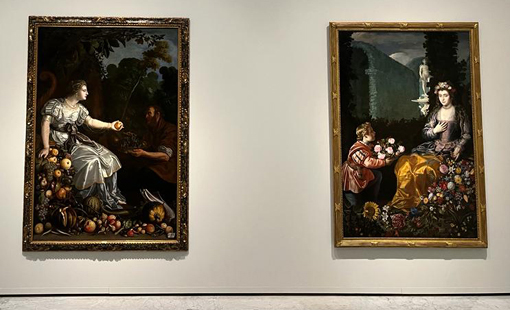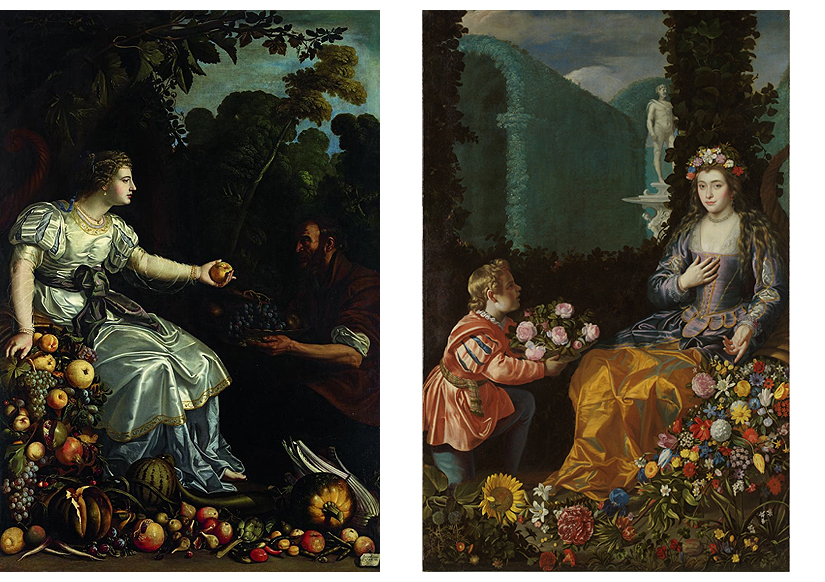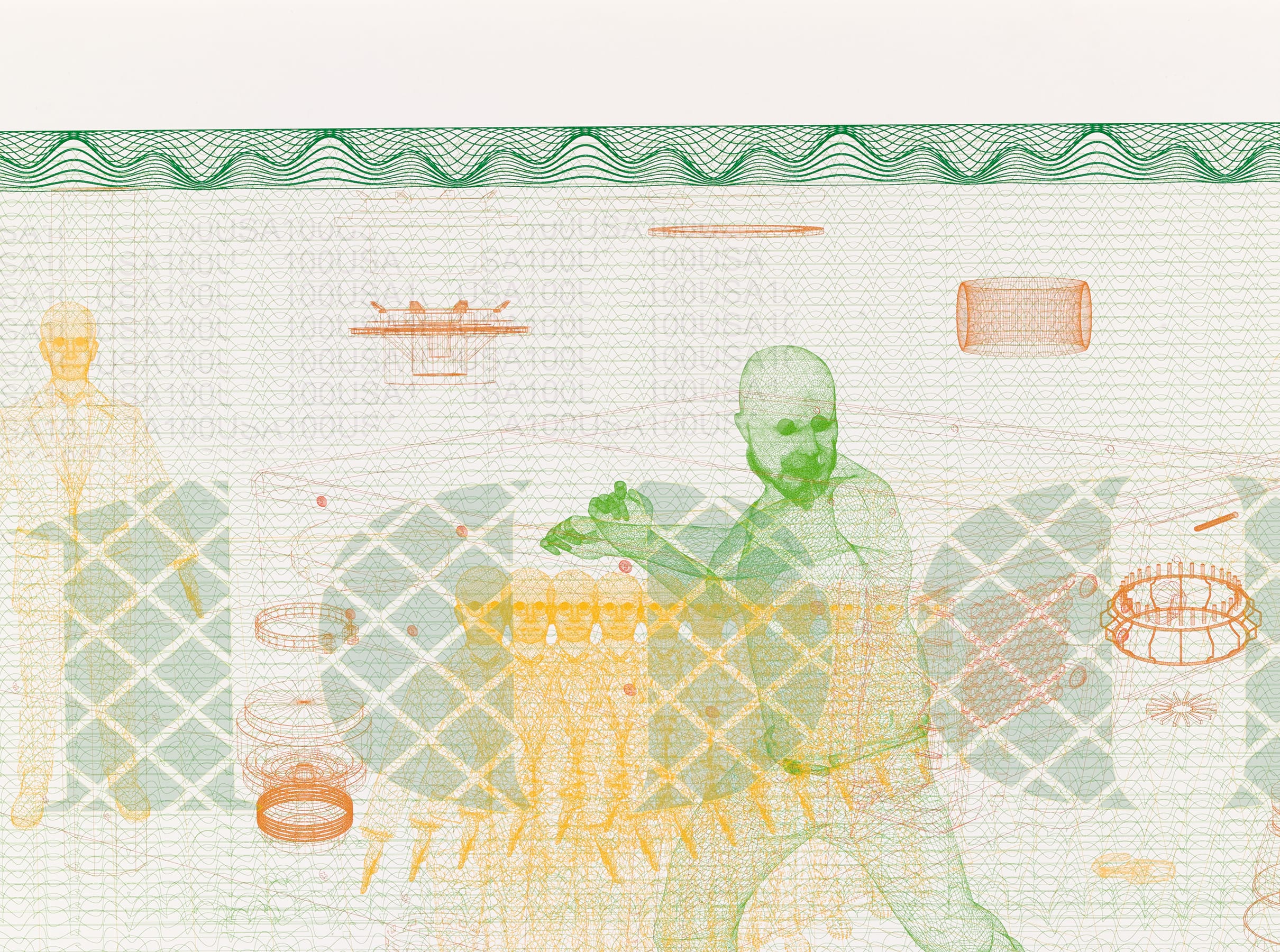
Last chance to visit "Flowers and Fruits", the exhibition that features both "Pomona and Vertumnus" and "An Offering to Flora"
With around 50 works by over 30 artists, the Flowers and Fruits exhibition looks at how still lifes have survived and changed over time. This is the second show at the exhibition hall created at the Banco de España headquarters following its recent refurbishment. At its heart are two pictures by Juan Van der Hamen (1596-1631), a Madrid painter of Flemish ancestry who achieved considerable success in early 17th century Madrid with his oil paintings of still lifes. The paintings in question are Pomona and Vertumnus (1626) and An Offering to Flora![]() (1627), two major works in his oeuvre, in which van der Hamen showcases his skill as a still-life painter (there are cornucopias containing fruit and flowers at the bottom of both paintings) but also as a painter of figures and mythological scenes, a far less well-known facet of his talent.
(1627), two major works in his oeuvre, in which van der Hamen showcases his skill as a still-life painter (there are cornucopias containing fruit and flowers at the bottom of both paintings) but also as a painter of figures and mythological scenes, a far less well-known facet of his talent.
The clear similarity in the iconography used —both works are themed around mythological deities used traditionally as allegories of the seasons, with Pomona representing summer and Flora spring— and their symmetrical, almost mirror-like layouts suggests that they were probably designed as a pair, though doubt has been cast on this hypothesis because of the slight differences in their sizes and the fact that they are not dated to the same year. The latest investigations seem to corroborate the theory that they share a common origin. Peter Cherry, one of the leading specialists in Spanish Baroque-period still-life and genre painting, believes it highly possible that the two works were hung as a pair on the walls of the palatial Madrid home of Jean de Croÿ![]() , second count of Solre, a Flemish nobleman who was Captain of the Royal Guard of Archers, to which the painter also belonged. This corps played a vital role in efforts to get the Flemish elite to support King Philip IV.
, second count of Solre, a Flemish nobleman who was Captain of the Royal Guard of Archers, to which the painter also belonged. This corps played a vital role in efforts to get the Flemish elite to support King Philip IV.
 Juan van der Hamen: Pomona & Vertumnus (1626) and An Offering to Flora (1627)
Juan van der Hamen: Pomona & Vertumnus (1626) and An Offering to Flora (1627)
Flowers and Fruits is an exceptional opportunity to see the two paintings, which have recently been restored, hanging together once again. The first, Pomona and Vertumnus, has been part of the Banco de España Collection since 1968. Alfonso Pérez Sánchez and Carlos Martín write that it owes a debt to the Flemish tradition of the late 16th century but also incorporates compositional features such as intense contrasts in light, with sharply marked shadows and a rounded treatment of volume, which recall the tenebrist naturalism of Caravaggio. Indeed, van der Hamen was one of the earliest followers of Caravaggio in Spain. In An Offering to Flora![]() , which is owned by the Museo del Prado
, which is owned by the Museo del Prado![]() , those compositional features are honed in depicting a female figure dressed in bright colours, with her hair worn loose, giving the picture the air of a portrait, since she is looking directly at the viewer.
, those compositional features are honed in depicting a female figure dressed in bright colours, with her hair worn loose, giving the picture the air of a portrait, since she is looking directly at the viewer.
As pointed out by Peter Cherry, the two canvases share a compositional and symbolic element in that they both feature cornucopias or horns of plenty, which have been used since antiquity to symbolise prosperity and celebrate the generosity of nature. They also enable the artist to show off his experience and skill as a still life painter. Cherry believes that the quantity and diversity of fruits depicted in the cornucopia in the case of Pomona & Vertumnus, and of flowers in that of An Offering to Flora, can be read on two different levels: on the one hand they are an appeal to the interest of a cultivated minority of viewers who enjoyed the painstaking process of botanical classification; and on the other they provide those viewers and indeed a broader audience with a joyful, multi-sensorial celebration involving sight, smell and even taste.
Aside from the cornucopias, there are also similarities in the central themes of the pictures: two Greco-Roman deities who have traditionally been shown as allegories of summer and spring, respectively. Pomona is associated with fertility and fruit-picking. Van der Hamen shows a scene that reflects the moment, as recounted by Ovid in Metamorphoses![]() , when the god Vertumnus disguises himself as a harmless old man to gain entry to the garden where she has taken refuge from her suitor. In this way, he gained her trust and sought to seduce her. Peter Cherry writes that the goddess is shown as 'an idealised figure of physical perfection'. Her features in profile, like those of Vertumnus, are based on engravings by Antonio Tempesta after drawings of fantastic heads by Michelangelo. Flora, however, seems to be a portrait of a real model, though her identity is unknown. As the goddess of spring, she personifies the ideals of youth and beauty, and can even be seen, in Cherry's words, as ‘a nuptial portrait or an epithalamium', with the multitude of flowers at her feet (almost seventy different varieties can be seen) symbolising the 'fertile spring of love'.
, when the god Vertumnus disguises himself as a harmless old man to gain entry to the garden where she has taken refuge from her suitor. In this way, he gained her trust and sought to seduce her. Peter Cherry writes that the goddess is shown as 'an idealised figure of physical perfection'. Her features in profile, like those of Vertumnus, are based on engravings by Antonio Tempesta after drawings of fantastic heads by Michelangelo. Flora, however, seems to be a portrait of a real model, though her identity is unknown. As the goddess of spring, she personifies the ideals of youth and beauty, and can even be seen, in Cherry's words, as ‘a nuptial portrait or an epithalamium', with the multitude of flowers at her feet (almost seventy different varieties can be seen) symbolising the 'fertile spring of love'.
![Juan Van der Hamen: Bodegón de frutas y dulces [c. 1921], Bodegón de frutas y cabeza de cabra (Bodegón de cocina) [c. 1925] y Bodegón de melones, cardo, dulces, carne y pescado [1925]. Vista de sala exposición Flores y frutos](/f/webca/ADS/Noticias/NotVanderHamenTxt0106.jpg) Juan Van der Hamen: Still life with Fruit and Sweetmeats [c. 1921], Still Life with Fruit and Goat's Head (Kitchen Still Life)[c. 1925] and Still Life with Melons, Thistles, Sweetmeats, Meat and Fish [1925]. View of the venue for the exhibition Flowers and Fruits.
Juan Van der Hamen: Still life with Fruit and Sweetmeats [c. 1921], Still Life with Fruit and Goat's Head (Kitchen Still Life)[c. 1925] and Still Life with Melons, Thistles, Sweetmeats, Meat and Fish [1925]. View of the venue for the exhibition Flowers and Fruits.
The section of Flowers and Fruits entitled The Baroque: Flowering and Fruitfulness features four still lifes by the same artist, dated between 1621 and 1625. Three of them are from our own Collection: Still Life with Fruit and Sweetmeats [c. 1621], Still Life with Melons, Thistles, Sweetmeats, Meat and Fish [1625] and Still Life with Fruit and a Goat's Head (Kitchen Still Life) [c. 1625]. The various foodstuffs, painted in oils, are laid out symmetrically, occupying the foreground against dark backgrounds that enhance their volumes, after the manner of Toledo-born painter Juan Sánchez Cotán![]() (1560-1627). All the foodstuffs shown could be found in the urban kitchens of the wealthy at that time, though Van der Hamen's intentions here are symbolic rather than documentary. Peter Cherry states that these still lifes seek to show 'a wealth of foods that transmits a sense of well-being to the viewer'. This attempt to create an effect of opulence and social refinement is highlighted by the plates, bowls and fruit baskets shown, which are made of luxury materials and elegantly decorated. A striking feature of Still Life with Fruit and Sweetmeats is the artist's skill in playing with the projection of objects over the front edge of the window ledge to create what Cherry calls 'the illusion of the continuity of the pictorial space in our own'.
(1560-1627). All the foodstuffs shown could be found in the urban kitchens of the wealthy at that time, though Van der Hamen's intentions here are symbolic rather than documentary. Peter Cherry states that these still lifes seek to show 'a wealth of foods that transmits a sense of well-being to the viewer'. This attempt to create an effect of opulence and social refinement is highlighted by the plates, bowls and fruit baskets shown, which are made of luxury materials and elegantly decorated. A striking feature of Still Life with Fruit and Sweetmeats is the artist's skill in playing with the projection of objects over the front edge of the window ledge to create what Cherry calls 'the illusion of the continuity of the pictorial space in our own'.
![Juan Van der Hamen: Bodegón con florero y perro [c. 1621], Pomona y Vertumno (1626) y Ofrenda a Flora (1627). Vista de sala exposición Flores y frutos](/f/webca/ADS/Noticias/NotVanderHamenTxt0105.jpg) Juan Van der Hamen: Still Life with Vase of Flowers and a Dog [c. 1621], Pomona & Vertumnus (1626) and An Offering to Flora(1627). View of the venue for the exhibition Flowers and Fruits.
Juan Van der Hamen: Still Life with Vase of Flowers and a Dog [c. 1621], Pomona & Vertumnus (1626) and An Offering to Flora(1627). View of the venue for the exhibition Flowers and Fruits.
The final still life by Juan Van der Hamen included in the exhibition is Still Life with Vase of Flowers and a Dog![]() [c. 1625], which is on loan from the Museo del Prado. With its unusual, vertical format, this picture was painted to adorn the antechamber leading to the main gallery in the palace of Flemish aristocrat Jean de Croÿ in Madrid. As in the other works featured here, Van der Hamen highlights the social status of his patron through the objects shown in the scene, such as the blue glass bowl in a gilded bronze stand that holds the bunch of flowers that occupies the top centre part of the canvas. The main feature of the bottom half is undoubtedly the dog from which the picture takes its name: a Bernese mountain dog whose pleading expression reinforces the trompe l'oeil effect which Peter Cherry describes as 'inscribed in the heart of the still life genre from its beginnings'. The artist uses this effect to draw the viewer into the pictorial space.
[c. 1625], which is on loan from the Museo del Prado. With its unusual, vertical format, this picture was painted to adorn the antechamber leading to the main gallery in the palace of Flemish aristocrat Jean de Croÿ in Madrid. As in the other works featured here, Van der Hamen highlights the social status of his patron through the objects shown in the scene, such as the blue glass bowl in a gilded bronze stand that holds the bunch of flowers that occupies the top centre part of the canvas. The main feature of the bottom half is undoubtedly the dog from which the picture takes its name: a Bernese mountain dog whose pleading expression reinforces the trompe l'oeil effect which Peter Cherry describes as 'inscribed in the heart of the still life genre from its beginnings'. The artist uses this effect to draw the viewer into the pictorial space.
